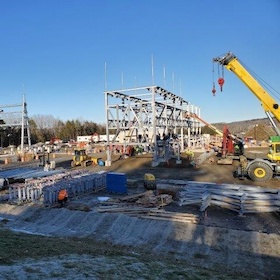Reliability Projects

Reliability Projects

About Reliability
Read MoreReliability Projects

Find out if you will be impacted by any of our upcoming Projects.
View our interactive map where you can enter your address
See MapReliability Projects

What's Happening
Construction InformationReliability Projects

Electric Transmission Reliability Projects
We're making improvements to better serve our communities
- We know you count on us to provide you with the power you need, when you need it, and we take that responsibility seriously. As part of our commitment to provide safe, reliable service to all our customers, we are investing in our delivery system which will provide additional power to fill growing demand, increase reliability, and accommodate growth and economic development in our service areas.
- All our upgrades and improvements mean one thing for you: you'll have reliable, high-quality power when you need it.
- To better serve our customers we are identifying electrical infrastructure that needs to be replaced and taking advantage of redundancy to make our delivery system more resilient.
System-wide upgrades to CMP's transmission and distribution equipment are vital to address the increasing demand placed on the Company's ability to meet customer needs. These projects include the upgrade and replacement of aging electric infrastructure, such as transformers and above ground/underground cable, and the building of new substations and transmission lines to increase the capacity of the system to meet customers' increased demand for electricity.
Map of Current Projects
Types of Projects
Substations – Connecting the regional transmission grid to our electric distribution network, substations are where 115-kV power is "stepped down” to 35kV for delivery to customers. Many of our current substations are 50+ years old and to assure the continued reliability of the system we will modernize or replace substations as needed. We also may reroute lines in and out of the substation.
Lines – upgrading, rerouting, and replacing overhead electrical lines, poles and transformers.
Construction Process
CMP is committed to working cooperatively with our customers, neighbors, community leaders, and regulators as we improve reliability while minimizing disruption to the environment and community. We have a dedicated team of public outreach liaisons who will be involved throughout the duration of these projects to answer any questions you may have.
Below are the stages of the project construction process that you may see in your community.
Substations:
- Clearing of land
- Drilling and pouring footings
- Digging and pouring foundations
- Installing Control House and devices within structure
- Gravel placed and graded
- Transformers installed and wired
- Fencing installed (if new site)
- Vegetation plan executed
- Testing then energizing of site

- IF replacement substation: Old substation deenergized then demolished and returned to natural vegetative state.
- IF expansion or modernization of existing site: Items being replaced/modernized removed, new gravel and grading and then steps to rebuild a substation as described above.
Lines:
1) Laying matting and building access roads for construction vehicles while protecting the area

2) Tree clearing – trimming "danger trees" that may cause service interruption

3) Drilling foundations which will support the new galvanized steel poles

4) Setting the bolt cage for the foundation structure

5) Pouring concrete for the foundations

6) Final concrete cap for the H-frame foundations

7) Setting the poles into the foundation

8) Stringing the wire (conductor) onto the poles

9) Restoration - grading, seeding & mulch. Access roads removed.

Updated September 2020
Permitting
CMP designs projects to avoid and minimize negative impacts to the community and the environment. Early project planning efforts included the completion of a set of resource assessments to clarify important planning considerations such as water resources, soil characteristics, cultural resources, and sensitive plant and animal species. Active regulatory coordination and reviews precede numerous permitting efforts and are ongoing through the construction phase of the project. CMP secures the necessary authorizations reviews and permits from agencies across federal, state and local administration agencies. CMP has sought consultation and permits from the following agencies where required:
Federal
- U.S. Army Corps of Engineers (USACE)
- U.S. Fish and Wildlife Service (USFWS)
- U.S. Environmental Protection Agency (EPA)
- Federal Aviation Administration (FAA)
- Coast Guard (USCG)
- Department of Agriculture (DOA)
- US Forest Service (USFS0
State of Maine
- Maine Public Utilities Commission (MPUC)
- Department of Agriculture, Conservation and Forestry (MDACF)
- Department of Environmental Protection (MDEP)
- Department of Transportation (MDOT)
- Maine Turnpike Authority (MTA)
- Land Use Planning Commission (LUPC)
Regional
- Regional commissions where applicable
Local
- Local Towns or Municipalities
Additional Links
| Title | Date |
|---|---|
| Forest Avenue Substation Fact Sheet | 08/16/2020 |
| Section 185 Fact Sheet | 03/01/2023 |
| Section 38 Fact Sheet | 03/01/2023 |
| Section 80 Fact Sheet | 02/13/2023 |
How the Electric Delivery System Works
The electric grid consists of high-voltage transmission lines and low-voltage distribution lines that transport electricity from power generation plants to community areas that need electricity.

Curious about EMFs?
Read more about it here.
Central Maine Power (CMP)
CMP, a subsidiary of AVANGRID, serves more than 636,000 electricity customers in an 11,000 square-mile service area in central and southern Maine. Affiliated with Iberdrola SA, AVANGRID owns eight electricity, natural gas or combination utilities in Connecticut, Maine, Massachusetts, and New York. The utilities serve 2.2 million electricity customers, 930,000 natural gas customers, and are recognized for safe, reliable energy delivery, excellent customer service, and a commitment to the community and environment.
For more information, visit avangrid.com | 1.888.267.0831 | [email protected]


